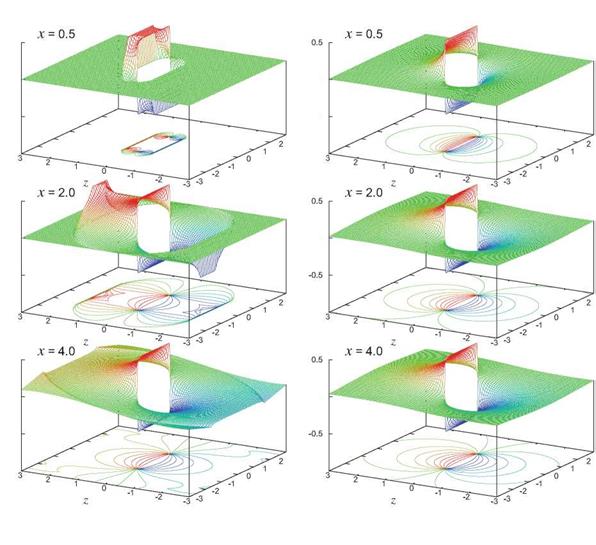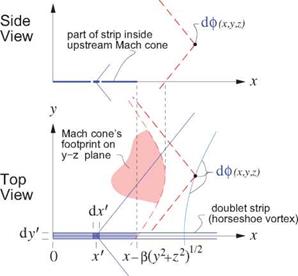Supersonic lifting flows Supersonic lift singularities
To represent the flow over lifting surfaces we need supersonic z-doublets which are derived from the source.
|
|
|
|
|
|
![]()
The corresponding y-doublet for modeling sideforce can also be considered. But this has exactly the same form as the z-doublet with y and z swapped, so there is no need to derive this separately.
We now define the potential of a semi-infinite z-doublet line extending downstream from the origin, which can be considered as a supersonic horseshoe vortex with an infinitesimal width dy.
 |
|
|
|
|
|
|
|
![]()
The upper integration limit over the doublet strip is the x’ point where the strip intersects the field point’s upstream Mach cone. This can be determined as the x’ point where the hyperbolic radius from the field point is zero.
h{x-x’,y, z;Moo) = J (X — X1)2 — fi2(y2 + Z2) = 0 —> xf = x — j3Jy2+z2
The alternative positive-root solution x’ = x + /І Jy2 I z2 is not used, since this con’esponds to the downstream Mach cone, and any doublet in this Mach cone has no influence on the field point.
As an example application of superposition of infinitesimal horseshoe vortices (8.160), the potential of a general unswept lifting line extending from y = — b/2 to y = b/2 is obtained by superposition of this unit solution across the span, with the appropriate y-coordinate shift.
 |
|
|
|
|
![]()
(:y-y’)2+z2 sjx2 – j32[{y-y’)2+z2]
|
|
 |
|
Figure 8.26: Integration over each doublet strip is restricted to region inside the field point’s upstream Mach cone.
The y1 and y2 integration limits are obtained by first finding the Mach cone where h(x, y-y’,z; MTO) = 0, which gives У = y± at the Mach cone. These are then clipped to within the lifting-line tips at ±b/2.

![]() У + y/(x/l3)2-z2 у – y/(x/f3)2-Z2 max{—b/2 , min[b/2 , y + ]} max {-b/2 , min[ b/2 , y – ]}
У + y/(x/l3)2-z2 у – y/(x/f3)2-Z2 max{—b/2 , min[b/2 , y + ]} max {-b/2 , min[ b/2 , y – ]}
For the specific case of a uniform Г(у) = constant distribution, which corresponds to one horseshoe vortex for the whole wing, the superposition integral (8.161) evaluates to the following form.
This is shown in Figure 8.27 over yz planes at three downstream x locations, and compared to the subsonic version for = 0.
Two limiting cases are:
|
Г [8] 2-7Г 121 |
|
Г * 2 R |
• Near the lifting line, such that with y± inside the tips (not clipped to ±b/2) and x being close to the z-axis and within the Mach lines from the vortex at the origin, we have the a solution of the 2D airfoil in the limit of zero chord.
This is shown in Figure 8.27 for x = 0.5 on the left.
 У
У
![]()
 |
||
Figure 8.27: Potential field over yz planes behind a supersonic (left) and subsonic (right) horseshoe vortex. Away from the Mach cone, the two flows become the same downstream. •
Hence, the Trefftz plane flow here is the same as with an incompressible freestream, as shown in Figure 8.27 for x = 8. For the intermediate downstream distance x = 2, The Trefftz plane flow appears subsonic close to the trailing legs, but supersonic farther away near the Mach cone trace.
Wave drag of a lifting surface
The flow over a general thin supersonic lifting wing can be obtained by superposition of infinitesimal supersonic horseshoe vortices (8.160) over its surface. The integration limits of such superpositions must obey the Mach cone dependence requirements, which can become complex for general wing planforms. One approach which handles these requirements in a systematic manner is the method of Evvard and Krasil – shchikova, as summarized by Ashley and Landahl [50].
The supersonic wave system created by the horseshoe vortex distribution will in general produce a wave drag due to lift, much like the line source representing a body produced a wave drag due to volume or thickness. Jones [64] determined the following minimum wave drag due to lift, which is obtained by a wing which has elliptical loading both in the spanwise and in the chordwise directions.
°’" = i<8Л66)
Combining this with the classical induced-drag relation (5.71) for the elliptical-loading case gives the total supersonic drag due to lift.
 |
|
This can also be given in the usual non-dimensional form using the lift and drag coefficient definitions.
The last term in (8.167) proportional to AR2 favors low aspect ratios so that the lift is distributed over a large chord. This is in direct contrast to the subsonic case, where the chordwise loading distribution is immaterial to drag due to lift. One practical consequence is that efficient supersonic configurations tend to favor relatively low aspect ratios in order to spread out the lift load in the chordwise direction.












